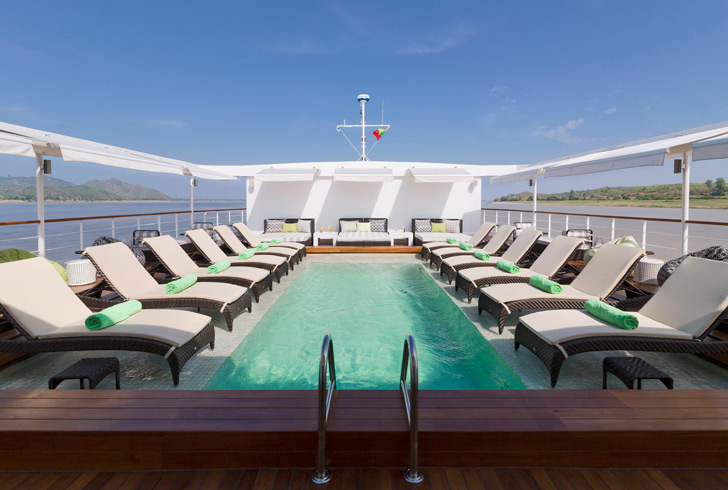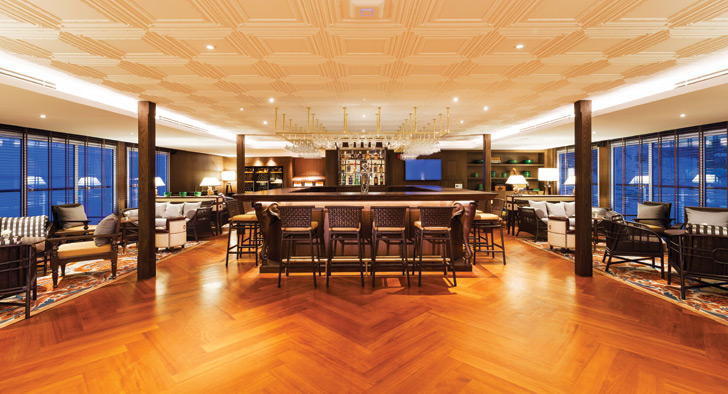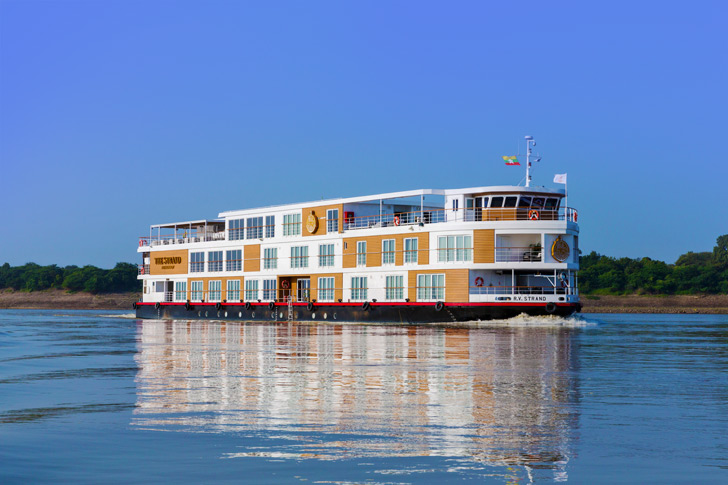The road to Mandalay was made famous by an ode in its honour, but the new five-star Strand Cruise along the riverine route to Myanmar’s cultural capital is a far more enticing way to travel
When the snow in the highest Himalayas melts, the Irrawaddy river swells almost to bursting each August. Yet by January, the water lapping at the banks of Myanmar’s life-giving river had receded so far that our ship occasionally had to alter its course.

Jutting out from the coffee-coloured waters were ridges and mounds of sand that the captain was no doubt keen to avoid. After all, the Strand Cruise, the floating offshoot of Yangon’s famed colonial-era hotel, had only been in service a few short months. An upside was found to those pesky sandbanks, however, in a manner typical of this trip: they provided the setting for imbibing glasses of champagne as twilight fell on the penultimate evening of the journey.
The Irrawaddy flows from those northern snow-capped peaks through the heart of Myanmar before emptying into the Andaman Sea, making it the country’s longest river. It is navigable for about 1,500km from its mouth, but for those who wish to soak up Myanmar’s key cultural sites, the stretch between Bagan and Mandalay holds the greatest allure.
Tourists have been traversing this course for several years, but the arrival of the Strand’s custom-built vessel, which took three years from conception to completion, makes it possible to do so without sacrificing the standards associated with the most luxurious of hotels.
At 23 square metres, with a full-sized bathroom, sitting area and sliding doors that open directly to river views, the size and comfort of my Strand Cabin defies expectations. The space is easily equivalent to land-lubbing accommodations, with classic teakwood furnishings, white linens and splashes of muted greens.

The journey begins in the ancient city of Bagan, the awe-inspiring home of more than 2,000 Buddhist temples. Even the drive from the airport to the boat is captivating, with tantalising glimpses of dozens of shrines rising up from the green fields that unfold in every direction. The first day’s itinerary includes stops at some of the area’s most celebrated sites: the ornate Ananda temple, built way back in 1091; Shwezigon Pagoda, with its gold leaf gilded stupa; and Gubyaukgyi temple, famous for its colourful yet gracefully worn wall paintings.
Overnight, the vessel remains docked in Bagan to allow a visit to Tant Kyi Taung pagoda, also known as the glass monastery, set on a hill overlooking the watercourse and the city beyond. Channe, our guide, herself a Christian from the Karen ethnic minority, explains that it is one of four holy sites where Burman Buddhists believe they must pray in order for a specific desire to come to pass. But there’s a catch: they must visit all four before midday. Its position across the river makes Tant Kyi Taung more difficult to reach, meaning that pilgrims visit it first, arriving soon after the sun begins to rise. By the time tourists start trickling in, it is nearly empty, save for a wizened monk smoking a cheroot with detached aplomb.
Interspersed with the consumption of temple architecture is the opportunity to explore the varied cuisine of chef Deang and his team. New à la carte menus appear at every meal, and sampling the array of Western fare interspersed with less-familiar Myanmar dishes is a highlight for many.
The itinerary is designed to be enjoyed at a leisurely pace, a welcome tempo for those envisioning the typically hectic schedule of many cruises. Afternoons are best spent sunning by the green-tiled pool, the contents of which swish back and forth with every bend in the river. On the banks, bucolic scenes of untouched rural life drift by, as farmers transport their produce on ox carts or tend their fields by hand. Come evening, guests make their way into the elegantly understated Sarkies Wine Bar, named after the Armenian brothers who founded the Strand back in 1901, where likeable staff mix up signature cocktails and more on request.
Of course, with such indulgences at hand, passengers might choose to spend the entire journey onboard – there is no obligation to join the excursions. One day when I’m feeling unwell – thanks to a bug picked up in Yangon – I opt out of touring Mingun, one of the country’s former capitals, and instead make use of the onboard spa. Choosing the one-hour ‘Sagaing Voyage’, the masseuse has magic fingers, although sadly not magic enough to cure my ails.
Even with all the onboard accoutrements, it is the cultural experiences that stick in the memory long after the journey has ended. There is a clear focus on introducing passengers to the country’s heritage, and with guided transport awaiting at the dock for each outing, along with the ever-attentive staff anticipating one’s needs on return, with iced drinks at the ready, joining in is rendered effortless.
A highlight of these cultural encounters is the pulsating ‘elephant dance’ at the foot of the hill leading to the glass monastery. Traditional musicians provide the live soundtrack for wiry young men who enter a multicoloured elephant costume and bring it to life with leaps and jumps, enthralling both tourists and the village children who gather to gape at the spectacle. During the course of the trip, guests are also treated to a captivating puppet show and invited to learn about traditional basket-weaving techniques.

Four days in, and the ship departs for its end destination. Mandalay, Myanmar’s cultural capital, is a striking bookend to the first day in Bagan. In the early morning, we visit U Bein Bridge, thought to be the oldest and longest teak bridge in the world. The 1.2km-long structure spans Taungthaman Lake, near Amarapura, another former capital situated 11km south of Mandalay. Not just a tourist site, the bridge remains in active use: locals wheel their bicycles across the rickety planks and saffron-robed monks stride purposefully by, while fishermen hunt for their catch in the still waters below.
Next, the group is whisked to Sagaing, the most important religious centre in Myanmar, for a speedy look at the area, which is famous for its many hundreds of pagodas and monasteries that dot the hillside in white, silver and gold.
In the late afternoon, the ship pulls up to Ava, the famous ancient imperial capital, where brightly painted horse-drawn carts await to transport us around the key monuments. Our chocolate-hued mare is amenable and clip clops along the red dirt paths in surefooted fashion. Ava, which played host to successive Burmese kingdoms from the 14th to 19th centuries, is now little more than a series of villages that provide a base for the sites – and is a personal favourite. Perhaps it’s the coolness of the dark, stone interior of Mae Nu Oak Kyaung monastery or the amiable feel of the 15th-century Yedanasimi pagoda, with its three Buddhas and crumbling brick stupa surrounded by working fields; it could just be down to soaking up a slightly less sanitised experience. Whatever the key ingredient, it makes for a magical send-off.
Keep reading:
“Down in the delta” – Captivating riverscapes await on the Aqua Mekong, a ship that sets five-star standards for regional river cruising

